The series of Thin Man movies answers the question, “What does happily ever after look like?”
Reacquainted with Myrna Loy and William Powell
Last week I went on a run of watching and writing about some Myrna Loy and William Powell movies I have in my collection. I went through four five of them, three four of which I’ve had here, unwatched, for about five years.
The Romantic John Wayne
It’s hard to think of John Wayne and romance at the same time. The image of one and the image of the other don’t rest well side by side; one seems to negate the other.
Hereafter and the storytelling Clint Eastwood
You might think focusing on the story when making a movie would be a no-brainer but, as quite a few movies seem to illustrate, it’s not. One of things I’ve always liked about Clint Eastwood is his insistence on the story first, foremost, almost exclusively.
Crawford and Gable and the oddball Strange Cargo
I stumbled upon Strange Cargo last night and rarely has the word “strange” in a title been used so appropriately. This movie is strange indeed. It’s also a pretty good adventure film starring Joan Crawford and Clark Gable (the latter’s previous movie was Gone With the Wind).
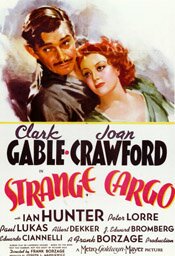 Strange Cargo (1940)
Strange Cargo (1940)
Directed by Frank Borzage
Crawford and Gable are two feisty lovers with a stormy relationship. Neither is a person of outstanding character. The storminess was likely easy for both to convey because in reality the pair, who had a prior relationship, detested one another.
In the movie, Crawford is essentially a hooker (though Hollywood censorship of the period means this is only vaguely suggested). Gable is a nasty, self-centered rogue who manages to be charming at the same time.
We find them on Devil’s Island (French Guiana) where they get mixed up with a group of convicts in an escape attempt. The majority of the movie is the struggles and conflicts of this rag tag bunch as they make their way through the jungle and swamps of the island and then on board a small ship as they try to get away.
Fine enough, and a pretty de rigueur setting for an adventure of the period. But there is an element in the movie that makes it anything but de rigueur. That element is the character of Cambreau, played by Ian Hunter. He appears mysteriously and joins the convicts in their escape but he is not your usual prisoner.
Cambreau is a Christ-like figure that steers the movie into religious allegory and allows the film to meditate on subjects like God, morality, ethics and honour. While this may not sound appealing (and yes, occasionally it is a little heavy-handed), the mysterious quality Hunter’s Cambreau figure brings adds to the adventure.
Gable, by the way, objected to this aspect of the movie. He thought it would prompt audiences to stay away. In his opinion, people expected love and sex in a Crawford-Gable movie.
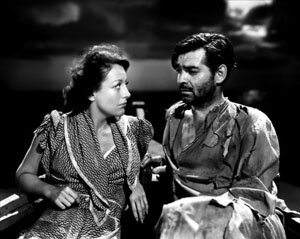
Both Crawford and Gable are wonderful in the movie, particularly Crawford as the slatternly Julie. I read somewhere that Crawford was quite proud of the way she put her “star” image aside and portrayed the character. I noticed how in many scenes she adds small, subtle touches to communicate the character’s “low rent” status, such as one scene where it is in how she sits (not what my mother would have called “lady-like”.)
She also went without makeup or false eyelashes and her costume, essentially two dresses, was from a bargain boutique.
Gable is equally unglamorous in his appearance, wearing torn clothes and growing increasingly unshaven as the movie progresses. In fact, the movie appears to make a concerted effort to ensure both its stars are unstar-like, visually.
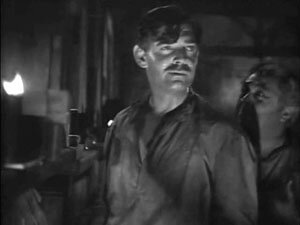
The end result is a movie that is peculiar yet compelling, partly due to its oddness. The Cambreau character, while bringing in the religious element, also adds mystery to the overall adventure as no one ever quite knows who he is.
On the other hand, some scenes aren’t subtle in communicating the Christ figure aspect, such as the scene near the end when Cambreau is in the stormy waters with his arms out, as if on a cross.
Yes, Strange Cargo is an odd movie. But it’s worth seeing at least once, especially if you’re a Gable or Crawford fan.
An aside … According to Warren Harris in Clark Gable: A Biography, this movie was made at a time when “Joan Crawford, whose box-office popularity had sunk an all-time low, had talked L.B. Mayer into teaming them (Gable and Crawford) for the first time since the 1936 Love On the Run, which was also Crawford’s last hit.”
Jean Harlow celebrates her centennial
I confess to knowing little about Jean Harlow beyond her name and her fame. I do know, however, that she was born March 3, 1911. That would be one hundred years ago.
If you do a little Google search, you’re sure to find fistfuls of tributes to the original platinum blonde.
I also know that before she was Jean Harlow, she was Harlean Harlow Carpenter and she was born in Kansas City. (Another confession? I have never heard of the name Harlean until now.)
Here is what I do know. Two movies I did not care much for, according to what I wrote about them, are Libeled Lady and Dinner at Eight. Both movies had something in common, though: Jean Harlow, and in both cases she was the one thing I did like. Imagine that.
In my review of Dinner at Eight, I wrote this: “It [the movie] does pick up however, especially when we finally get to meet Jean Harlow, who is a joy to watch. She brings a wonderful note of comedy to the film and infuses it with some badly needed energy.”
Happy birthday Jean! I now know what I have to do: track down more Jean Harlow movies and find out more about this woman so I don’t have to plead ignorance when her name comes up.
Barbara Stanwyck must have liked working
Without intending to, I’ve found myself watching a lot of Barbara Stanwyck movies lately, including Double Indemnity (of which I’d like to scribble something one of these days). I believe IMDb shows she appeared in 101 movies and TV shows in her career. She really must have liked working.
I realized I have 18 Stanwyck movies on DVD (only a small number relative to her output). Of those, I’ve watched 15. There are three I’ve yet to see (but plan to): To Please a Lady, Jeopardy and Stella Dallas. Of the 15 watched, I’ve only written about a few, such as this one below. I watched it just last week.
My Reputation (1946)
Directed by Curtis Bernhardt
It seems a strange thing to say but My Reputation suffers from an actor’s performance that is too good.
Barbara Stanwyck portrays Jessica Drummond so well, you almost fume with frustration with her in the movie’s first half.
That’s not actually the case, however.
The problem is the movie and using its first third to create a portrait of a conflicted woman – it’s really a lot of exposition. As the Variety review from 1945 points out, the movie’s other star, George Brent, doesn’t make an appearance for about a half hour or so.
My Reputation is a romantic melodrama and, once the first third is over and certain things are established, entertaining in an average kind of way. Actually, thanks to Stanwyck’s performance, it’s above average. While a romance, it is also about psychological conflict and it’s that element where Stanwyck really excels.
Jessica Drummond is a recent widow who suffers from a domineering mother and friends who are superficial at best. She wants to assert herself as an individual, having been lost for years as secondary to others, but she can’t bring herself to do so. She makes a number of false starts.
This is what I mean about frustration: Stanwyck portrays the conflict so well that, if you are me, while sympathetic you want to tear your hair out because she is so mousy. However, once a new love shows up in the form of George Brent as Major Scott Landis the movie picks up as Stanwyck’s character becomes increasingly stronger.
It’s true the movie is dated, as some have pointed out, but I didn’t find that a particularly difficult barrier to get past, no more so than a historical film or book would be. It’s not a movie for everyone – despite the psychological aspect, it’s essentially a love story, a romantic fantasy.
If you don’t like romances, you probably won’t like this movie. On the other hand, if you want to see yet another brilliant Barbara Stanwyck performance, you really shouldn’t miss this one.
Blogathon Update:
- Self-Styled Siren has an update on the For the Love of Film (Noir) blogathon, including a specifically for the blogathon. Get ready! It begins Valentine’s Day (February 14) and runs through till February 21. Oddles of bloggers talking about film noir and film preservation.
Guy movie with Gable and gravitas
I’m always astonished when I notice the movies Robert Wise has been involved with, particularly as director. I tend to think of him as a “meat and potatoes” kind of director because I don’t notice him. His movies never draw attention to themselves as movies; they’re simply stories told well.
As an editor, he worked with Orson Welles on Citizen Kane. As director, he’s done movies like The Sound of Music, The Haunting, West Side Story (as co-director) and the movie below, Run Silent, Run Deep.
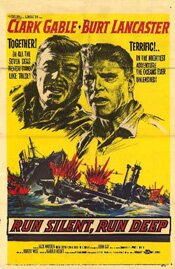 Run Silent, Run Deep (1958)
Run Silent, Run Deep (1958)
Directed by Robert Wise
I saw an interview with the actor Laurence Fishburne the other day in which he was speaking of various influences when he was young. At one point, he brought up the movie Run Silent, Run Deep and Clark Gable. What struck him in the movie was Gable’s gravitas. I immediately thought, “Yes, that is the perfect word for it.”
Fishburne brought this up because Gable would have been in his late 50s when he made the film.
He was not playing the young, dashing, romantic figure of movies like Gone With the Wind. And he wasn’t playing the great white hunter of Mogambo, made only five years earlier.
He does, however, play a “manly man,” which would have had great appeal for him, from the little I know of Gable.
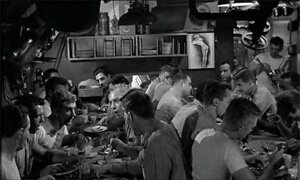 Run Silent, Run Deep is a guy movie. There are really only two female roles in the movie: a very small part as Gable’s wife (Mary LaRoche) and a pin-up poster. It’s all guys and for the most part they are confined in a submarine. Despite that, it’s a good movie. Actually, it is because of that it is a good movie. It knows what it is about and its focus doesn’t waver.
Run Silent, Run Deep is a guy movie. There are really only two female roles in the movie: a very small part as Gable’s wife (Mary LaRoche) and a pin-up poster. It’s all guys and for the most part they are confined in a submarine. Despite that, it’s a good movie. Actually, it is because of that it is a good movie. It knows what it is about and its focus doesn’t waver.
Gable is submarine Commander Richardson, a man who, as we see in the opening scenes, loses the sub he commands when it is sunk by a Japanese destroyer, one that acquires a kind of legendary status because it is so successful in sinking U.S. subs. (The movie is set during World War II.)
After a long wait, Richardson gets another command (one he has specifically gone after). Unfortunately, that sub’s crew thinks their first officer, Lieutenant Jim Bledsoe (Burt Lancaster) is getting the command, as does Bledsoe. When Richardson comes aboard to take over, it is to a resentful crew and first officer.
Things don’t improve when he makes the crew go through the same drill repeatedly, obsessed with shaving seconds off the time it takes to dive and launch torpedoes. It further degrades when this new commander appears to avoid going after Japanese ships. It strikes the crew as cowardly.
It turns out the commander has plans: against orders, he intends to take the sub into dangerous waters and sink the unsinkable ship that is taking out all the U.S. subs, including Commander Richardson’s previous submarine.
It’s a simple, direct story and won’t ever be accused of being overly sophisticated. But it’s virtue is its simplicity and directness. Director Robert Wise has left nothing necessary out and has put nothing unnecessary in.
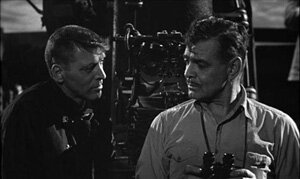 Gravitas, like the word gravity, comes from the Latin word “gravis” which means seriousness or weightiness. Gable communicates it wonderfully. Lancaster does to a degree too, though in a different way. Between the two actors, you get a nicely dramatic contrast.
Gravitas, like the word gravity, comes from the Latin word “gravis” which means seriousness or weightiness. Gable communicates it wonderfully. Lancaster does to a degree too, though in a different way. Between the two actors, you get a nicely dramatic contrast.
Gable, outside moments of command, speaks in a drawling, friendly manner. In moments of command, he’s brusque and direct. Lancaster, on the other hand, with his character’s resentment, speaks in a clipped fashion. He also communicates a sense of simmering anger that only his naval discipline keeps in control.
It’s the dynamic between the two characters that really propels this movie, though a straightforward, determined plot nicely aids it.
I’ve seen this movie several times over the years and have liked it every time. Initially, I was a young boy and thought it was cool because it had submarines and torpedoes. Grown up, I like it because it is just a good, well told story.
Sullavan, Stewart and Box 237
I actually wrote the ‘review’ below about ten years ago. But I watched The Shop Around the Corner a few days ago and wanted to make a few changes, though I also forced myself to leave in some of the howlers, like the “wow” business.
It still doesn’t say what I’d like to say about Lubitsch (not that it’s anything life changing). But my last post and this one are part of me getting to what it is I’d like to write. Have I mentioned how much I love his movies?
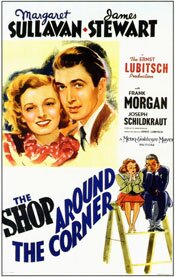 The Shop Around the Corner (1940)
The Shop Around the Corner (1940)
Directed by Ernst Lubitsch
Wow. What a great movie! I suppose that’s why so many remakes have followed it, including You’ve Got Mail. But while the attempts may have been well-meaning, there’s nothing like the original, The Shop Around the Corner.
One of the interesting things I find about this film is the fact that the setting, even the story, are so unlikely, so lacking in credibility, yet the film is unquestioningly true. How does that happen? The movie could care less about whether or not it is realistic. It’s pure romantic fantasy. (Think about it: Jimmy Stewart as a sales clerk in a gift-shop in Budapest?)
Yet reality informs the story and its characters. But it’s not the objective reality of science and journalism; it’s the reality of behavior and relationships. It’s the reality of people.
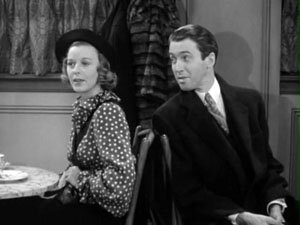 The conceit of the film is pretty simple, which may be why it is such a template for other movies: Alfred (Jimmy Stewart) and Klara (Margaret Sullavan) have begun corresponding by letter as the result of Alfred stumbling across a classified ad Klara has put in the paper for a pen-pal. Both become enamoured of the person they think they are corresponding with.
The conceit of the film is pretty simple, which may be why it is such a template for other movies: Alfred (Jimmy Stewart) and Klara (Margaret Sullavan) have begun corresponding by letter as the result of Alfred stumbling across a classified ad Klara has put in the paper for a pen-pal. Both become enamoured of the person they think they are corresponding with.
A romance develops between them though they have never met. Within the fantasy that is the movie, we have two characters living fantasy lives.
In the meantime, Klara has become a clerk in the same shop where Alfred is the longest serving employee. The two find they can’t stand one another; they continually bicker.
There are various complications along the way, but you can guess where the film is going. Eventually the truth must come out, and it does.
The film works well for a number of reasons. One of these is the directing of Ernst Lubitsch. Everything flows, and there is total acceptance of the fantasy world. The performances he gets from his cast are also flawless. They’re wonderfully nuanced performances.
Jimmy Stewart portrays Alfred so naturally it’s hard to imagine it’s acting. (It’s very similar to the easiness of the performance he gives in a film like Harvey.)
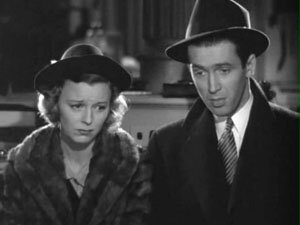 Margaret Sullavan is a terrific companion for him and the supporting cast, especially Frank Morgan (the Oz from The Wizard of Oz), are also brilliant.
Margaret Sullavan is a terrific companion for him and the supporting cast, especially Frank Morgan (the Oz from The Wizard of Oz), are also brilliant.
The Shop Around the Corner is an almost perfect romantic comedy. It does everything a romantic comedy should do. It feels real while being so obviously fantastic. It’s one of the most delightful and charming films ever made.
I also highly recommend reading Self-Styled Siren’s piece on Jimmy Stewart and The Shop Around the Corner. It’s called .


